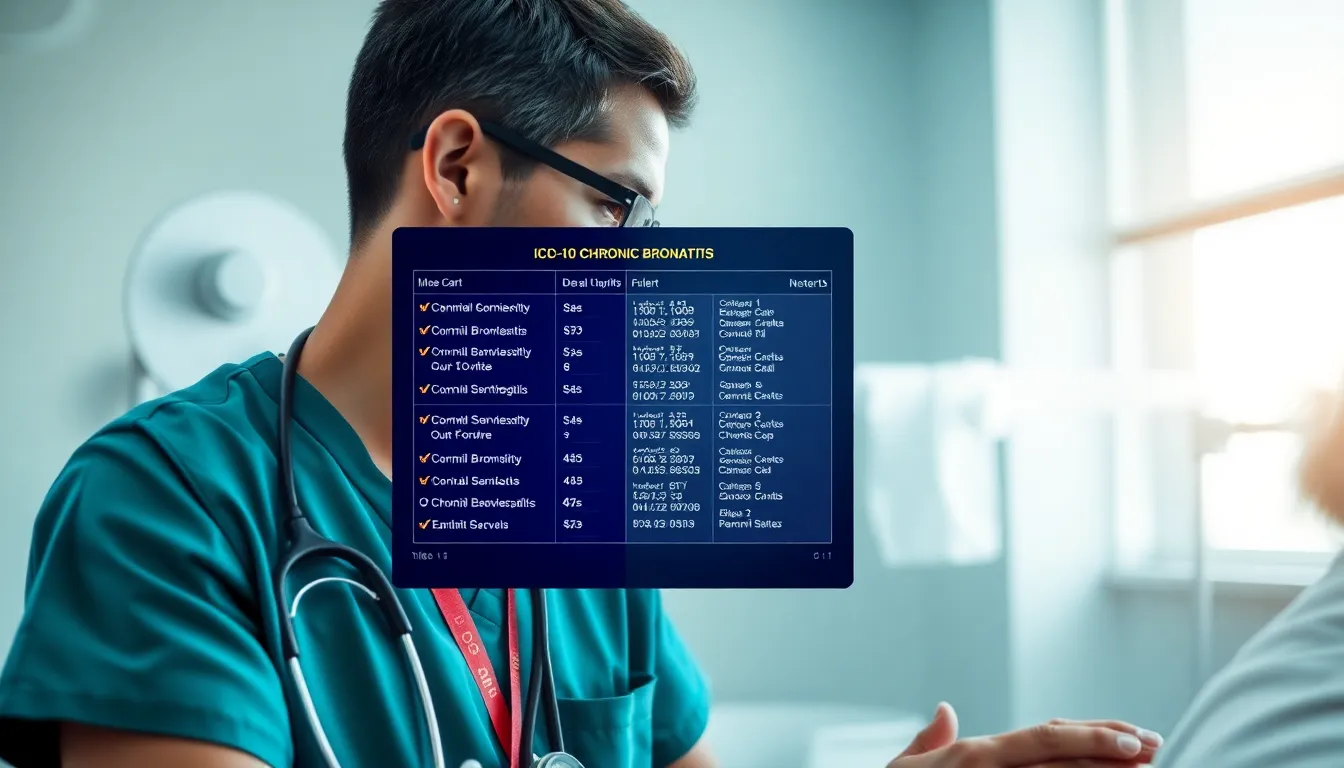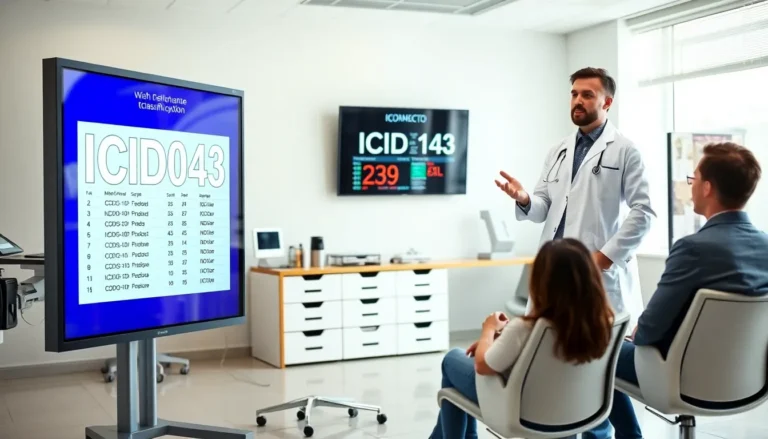Table of Contents
ToggleChronic bronchitis is a persistent respiratory condition that affects millions, leading to coughing and breathing difficulties. Understanding its classification is crucial for accurate diagnosis and treatment. The ICD-10 code for chronic bronchitis helps healthcare providers communicate effectively and ensure patients receive the right care.
With the right code, medical professionals can streamline billing and track health outcomes more efficiently. This article delves into the specifics of the ICD-10 code for chronic bronchitis, offering insights into its significance and usage. Whether you’re a healthcare provider or someone seeking to understand this condition better, grasping the coding system is essential for navigating the complexities of chronic bronchitis.
Overview of Chronic Bronchitis
Chronic bronchitis is a significant respiratory condition identified by inflammation of the bronchial tubes and excessive mucus production. Understanding this condition aids in more effective patient management and coding practices.
Definition and Symptoms
Chronic bronchitis consists of a persistent cough that produces mucus for at least three months over two consecutive years. Symptoms include:
- Cough: A frequent, productive cough, often worsens in the mornings.
- Mucus Production: Increased production of thick, discolored mucus.
- Wheezing: A whistling or squeaky sound during breathing.
- Shortness of Breath: Difficulty in breathing, particularly during physical activity.
- Fatigue: Persistent tiredness and reduced energy levels.
These symptoms can vary in severity and may exacerbate during respiratory infections.
Causes and Risk Factors
Chronic bronchitis results from prolonged irritation and inflammation of the bronchial tubes. Common causes and risk factors include:
- Smoking: Tobacco smoke is the primary cause, with both active and passive smokers at risk.
- Air Pollution: Exposure to industrial pollutants and inhaling allergens contributes to the condition.
- Respiratory Infections: Frequent infections can lead to chronic changes in the bronchial tubes.
- Genetic Factors: Individuals with a family history of lung diseases exhibit a higher risk.
- Age: Older adults often experience more severe forms of chronic bronchitis due to natural lung function decline.
Recognizing these causes and risk factors helps in targeting preventive measures and treatment strategies.
Understanding ICD-10 Codes

ICD-10 codes play a crucial role in the healthcare system, allowing for precise classification of diseases and conditions like chronic bronchitis. Understanding these codes is vital for accurate diagnosis, treatment, and communication among healthcare providers.
Purpose and Importance
ICD-10 codes serve multiple purposes. They facilitate diagnosis documentation, ensuring healthcare providers can track chronic bronchitis cases effectively. Accurate coding supports efficient billing practices and enables better management of healthcare resources. Tracking health outcomes through these codes helps identify trends and improve patient care.
How ICD-10 Codes Are Structured
ICD-10 codes follow a specific format. Each code consists of alphanumeric characters that correspond to particular medical conditions. The first character is a letter, indicating the chapter related to the condition. The subsequent characters provide further specificity, including features like severity and complications. For chronic bronchitis, the relevant codes fall under the categories of acute and chronic respiratory conditions, enabling precise identification of the patient’s status and related symptoms.
ICD-10 Code for Chronic Bronchitis
Chronic bronchitis falls under specific ICD-10 codes that aid in accurately documenting and managing the condition. Recognizing the correct codes allows for effective communication among healthcare providers and supports billing and insurance processes.
Specific Codes and Descriptions
The primary ICD-10 codes for chronic bronchitis include:
| ICD-10 Code | Description |
|---|---|
| J41.0 | Simple chronic bronchitis |
| J41.1 | Mucopurulent bronchitis |
| J42 | Unspecified chronic bronchitis |
| J44.9 | Chronic obstructive pulmonary disease (COPD), unspecified |
These codes provide healthcare professionals with precise classifications, facilitating targeted treatment and management strategies.
Differentiating Between Types of Bronchitis
Chronic bronchitis has distinct categories based on symptoms and severity:
- Simple Chronic Bronchitis (J41.0): Characterized by a chronic productive cough without respiratory obstruction or significant airway narrowing.
- Mucopurulent Bronchitis (J41.1): Involves the presence of purulent sputum, indicating more severe inflammation of the bronchial tubes.
- Unspecified Chronic Bronchitis (J42): Used when specific characteristics of bronchitis are not detailed but chronic inflammation is present.
- Chronic Obstructive Pulmonary Disease (J44.9): Encompasses chronic bronchitis with airflow limitation, emphasizing its impact on overall respiratory health.
Understanding these distinctions helps healthcare providers offer tailored treatment plans, improving patient outcomes.
Benefits of Accurate Coding
Accurate coding plays a crucial role in the management and treatment of chronic bronchitis. It enhances patient care and streamlines billing processes in healthcare.
Improved Patient Care
Accurate coding ensures precise documentation of chronic bronchitis diagnoses. It enables healthcare providers to tailor treatment plans based on specific code distinctions. For instance, coding differentiates between simple chronic bronchitis (J41.0) and mucopurulent bronchitis (J41.1), facilitating targeted therapeutic approaches. Furthermore, accurate coding helps track disease progression and responds effectively to patient needs, ultimately improving health outcomes.
Streamlined Billing Processes
Accurate coding significantly streamlines billing for chronic bronchitis-related services. It increases efficiency during claims submissions and decreases the likelihood of claim denials due to coding errors. Correct codes align with insurance reimbursement policies, ensuring healthcare providers receive appropriate compensation for services rendered. Effective use of ICD-10 codes also facilitates monitoring healthcare expenditures and resource allocation, benefiting healthcare systems.
Understanding the ICD-10 code for chronic bronchitis is essential for effective healthcare management. Accurate coding not only aids in precise diagnosis and treatment but also enhances communication between healthcare providers and patients. By recognizing the specific codes associated with chronic bronchitis, professionals can tailor treatment plans to meet individual patient needs.
Additionally, proper documentation supports efficient billing practices and improves overall health outcomes. As chronic bronchitis remains a prevalent condition, awareness of its coding can significantly impact both patient care and healthcare efficiency. Emphasizing accurate coding ultimately leads to better management of chronic bronchitis and a more streamlined healthcare experience.







